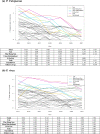Projecting malaria elimination in Thailand using Bayesian hierarchical spatiotemporal models
- PMID: 37179429
- PMCID: PMC10182757
- DOI: 10.1038/s41598-023-35007-9
Projecting malaria elimination in Thailand using Bayesian hierarchical spatiotemporal models
Abstract
Thailand has set a goal of eliminating malaria by 2024 in its national strategic plan. In this study, we used the Thailand malaria surveillance database to develop hierarchical spatiotemporal models to analyze retrospective patterns and predict Plasmodium falciparum and Plasmodium vivax malaria incidences at the provincial level. We first describe the available data, explain the hierarchical spatiotemporal framework underlying the analysis, and then display the results of fitting various space-time formulations to the malaria data with the different model selection metrics. The Bayesian model selection process assessed the sensitivity of different specifications to obtain the optimal models. To assess whether malaria could be eliminated by 2024 per Thailand's National Malaria Elimination Strategy, 2017-2026, we used the best-fitted model to project the estimated cases for 2022-2028. The study results based on the models revealed different predicted estimates between both species. The model for P. falciparum suggested that zero P. falciparum cases might be possible by 2024, in contrast to the model for P. vivax, wherein zero P. vivax cases might not be reached. Innovative approaches in the P. vivax-specific control and elimination plans must be implemented to reach zero P. vivax and consequently declare Thailand as a malaria-free country.
© 2023. The Author(s).
Conflict of interest statement
The authors declare no competing interests.
Figures





References
-
- Bureau of Vector Borne Diseases, Department of Disease Control, Ministry of Public Health, Thailand. Guide to Malaria Elimination for Thailand’s Local Administrative Organizations and the Health Network. (Bureau of Vector Borne Diseases, Department of Disease Control, Ministry of Public Health, Thailand, 2019).
-
- World Health Organization (WHO). Thailand gears up to eliminate malaria by 2024. https://www.who.int/news-room/feature-stories/detail/thailand-gears-up-t...(2021). Accessed 15 March 2022.
Publication types
MeSH terms
Grants and funding
LinkOut - more resources
Full Text Sources
Medical

